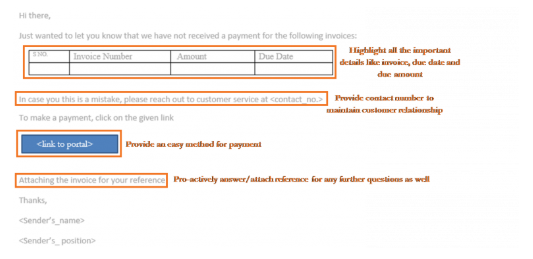The 11 Unbeatable Collection Templates
This ebook unveils the 11 most effective email templates that will help you collect your receivables faster. The ebook is a culmination of our work with credit and collection experts over more than 400 credit and A/R transformation projects across the world.
The 11 Unbeatable Collection Templates
Pro-active payment reminders
Best-practices:
- Be polite ? remember that this is just a pro-active reminder; do not assume that the customer will default
- Clearly specify the invoices and the due-dates
- Urge them to make a payment with their earliest A/P run
- Share options for easy payment methods through an EIPP portal

Early-payment discount reminders
Best-practices:
- Clearly call out the offer ? a discount on early payment
- Clearly spell out the date by which payment must be made
- Detail any invoices with the actual amounts to be paid ? this clears any confusion in buyers manually calculating final amounts
- Urge them to make a payment with their earliest A/P run
- Provide convenient payment options

First past-due reminders
Best-practices:
- Clarify whether the customer has received any previous invoice copies
- Call out the invoices for which payment has been delayed ? specify the actual date
- Ask the customer to reach out to customer serivce in case of any issues
- Offer convenient payment options

Second past-due reminder
Best-practices:
- Clearly inform about the delay in payment
- Call out the email as a ?second? past-due reminder
- Remind the customer to make a payment at their earliest possible
- Offer the option of making a payment commitment through your EIPP portal
- Offer convenient payment options
- Attach the original invoices to avoid further to and fro in requesting invoice information

Third past-due reminder
Best-practices:
- Call out the possible outcomes for further non-receipt
- Drop any non-essential courtesy or flowery language
- Remind the customer to make a payment at their earliest possible
- Offer convenient payment options
- Offer the option of making a payment commitment through your EIPP portal
- Attach the original invoices to avoid further to and fro in requesting invoice information

Suspension of credit
Best-practices:
- Inform about discontinued credit
- Clearly specify the reason for discontinuation of credit to the account
- Call out the total value of outstanding or past-due invoices
- Offer reaching out directly to a customer service representative as the first option
- Offer convenient payment options
- Offer the option of making a payment commitment through your EIPP portal
- Attach the original invoices to avoid further to and fro in requesting invoice information

Default on payment commitment
Best-practices:
- Use this as a polite reminder about the unfulfilled payment commitment
- Include the details of the invoice, amount and promised payment date
- Ask the customer to contact a customer service representative for any help in facilitating the payment
- Offer convenient payment options
- Attach the original invoices to avoid further to and fro in requesting invoice information

Escalation notice
Best-practices:
- Clearly specify that this is an extra-ordinary circumstance in which the recipient is being reached out to
- Highlight all the information they need to help process the payment
- Offer convenient payment options
- Attach the original invoices to avoid further to and fro in requesting invoice information
- Use this template sparingly to avoid diluting its impact and value

Collecting from key accounts
Best-practices:
- Appreciate the relationship with the customer
- Be polite and helpful with any additional details they may need in processing the payment
- Offer convenient payment options
- Attach the original invoices so that all information is available in one place

Collecting from Slow-paying customers
Best-practices:
- Share all information required in a single place
- Be up-front about the implications of continued delay in payments
- Offer support in answering any questions
- Offer convenient payment options

Collecting from Fast-paying customers
Best-practices:
- Be polite ? these customers have always paid you on-time
- Offer the benefit of doubt and ask them to reach out to customer service for any help
- Offer convenient payment options
- Attach the original invoices so that all information is available in one place

